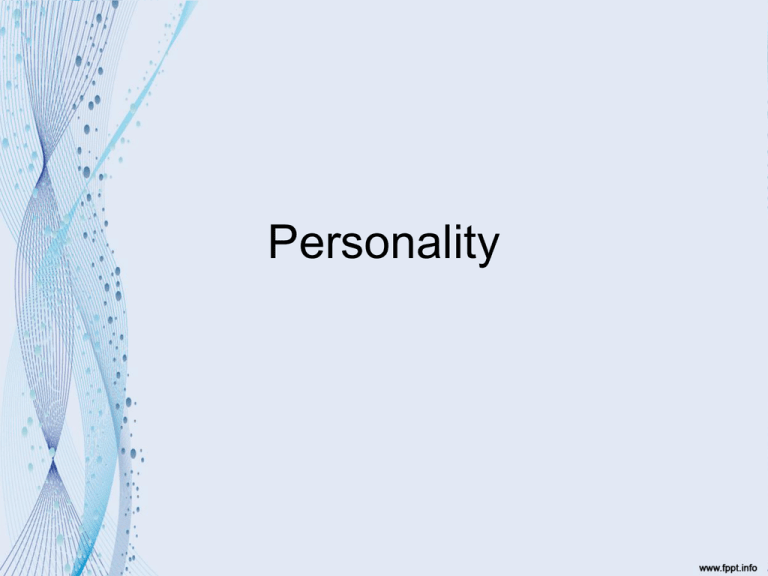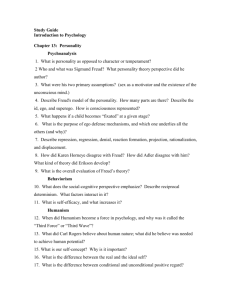Personality - Rosehill
advertisement

Personality Personality • What is personality? • Theories of Personality – Psychodynamic (Freud) – Humanistic (Rogers) – Trait • Personality Testing and Uses • Evaluation of both personality theories and personality testing Some definitions: • Personality, temperament, mood and character all have different definitions • Temperament is the way in which we react to different situations. It is thought to be genetic. You can be described as hot-tempered or mild-tempered. • Mood refers to a short-lived state related to how we feel at a particular moment in time. Mood can cause you to act out of character. • Character is closely related to personality. Its a general description for the sum of all of your traits. E.g. A strong character Defining Personality • “ A relatively stable set of characteristics specific to an individual that determine how that individual acts and behaves” • Every person has a unique personality; no two people are the same • 5 traits activity • We need to remember that we do change our behaviour with context. Our personality is something that we can describe. It will explain our behaviour in different contexts. • For example, describe to me the way you behave around your grandparents.... For example.... • The way you behave around your grandparents and the way you behave around your friends is likely to be very different. You respect your grandparents and want to impress them. You may mind your language and make polite conversation. Maybe you only speak when spoken to. Around your friends you are loud. You tell your friends exactly what you are thinking and feel free to interrupt them and argue. • Your behaviour in these different contexts has changed but this does not mean your personality has changed. • Despite this change in behaviour, you are more than likely able to make a list of “traits” that you have. The sum of all of these traits is your personality. Nature vs. Nurture • Do we have a personality gene or is personality determined by the environment we grew up in? • If there is an interplay of both are genes or the environment more influential? Nature • Studies have found a strong link between genetics and personality. Identical twins raised in the same home have more similar personalities that fraternal twins raised in the same home. • Identical twins raised in different homes also have very similar personalities, almost just as similar as identical twins raised in the same home. • Although there appears to be a strong genetic link, in none of the studies were the personalities of identical twins exactly the same. As their genes are exactly the same, this would suggest that there is indeed an environment influence. Research continues into this debate. Theories of Personality • We will look at three theories of personality: – Psychodynamic: personality is shaped by the experiences of childhood – Humanistic: we choose our own personality – Trait: personality is genetic and we are born with a particular personality The • Developed by Sigmund Psychodynamic Freud Theory of • Claims that our Personality personality has three components each with their own agenda • These three components are known as: 1. Id 2. Ego 3. Superego Id • Driven by biological forces • We experience discomfort when Id is not satisfied i.e. feeling hungry or thirsty • Can cause tension when biological urges are in conflict with the other parts of personality. • Id works on the pleasure principle. Id wants its urges met now and pays no attention to any consequences! Ego • Ego creates ways in which to meet the demands of Id within societal boundaries. • The ego develops from the Id during childhood. • Ego works on the reality principle. Ego tries to balance the needs of Id with the needs of Superego. Ego is the voice of reason. Superego • Superego develops from ego as a result of learning and socialisation. • Superego works on the morality principle. It uses the morals that we have learnt from our parents, friends and teachers to guide behaviour and avoid guilt. An example... M.H. is a university student who is attracted to a girl he sees occasionally at the recreation centre. His id craves for immediate satisfaction (you know what I mean) but this is opposed by his superego (which finds reasons why he shouldn’t even be thinking about these desires). The Id says “Go for it!”. The Superego replies “Don’t even think about it!”. And what does the ego say? “I have a plan!”. The Mind by Freud • As well as proposing that personality was made up of three components, Freud described the mind as being made up of three levels: 1. The conscious mind 2. The pre-conscious mind 3. The subconscious/unconscious mind Three Levels of the Mind • Level 1: The conscious mind contains feelings and thoughts of which we are aware of at a particular point in time • Level 2: The pre-conscious mind contains thoughts and feelings that we are not aware of but can easily access when required. These thoughts and feelings are said to be just under the surface of our consciousness. • Level 3: The unconscious mind is argued by Freud to be the largest and most influential part of the mind. We are totally unaware of the feelings and thoughts that reside here though they may influence behaviour. Freud would further ague that only a psychologist trained in psychoanalysis could access these thoughts and feelings. The Iceberg • Freud suggested that Id is found only in the unconscious while Ego and Superego can be found on all levels. • The iceberg analogy is used to indicate that most of the mind in subconcious just as most of an iceberg is submerged. Psychosexual Development • Freud proposed that that way in which we resolve issues between the different parts of our mind develops during childhood and helps to shape personality. • During childhood we have to balance different biological and environmental influences. • A well-balanced personality is the result of successfully moving through each stage. • If a stage is not successfully completed, a fixation with develop. A fixation is the attachment to a behaviour or object later in life. Evaluation of Freud’s Theory • Was considered very contemporary because it was one of the first theories that linked symptoms to an underlying cause. Freud believed that rather than treat the symptoms of his clients, he would try to uncover and treat the underlying cause of their abnormal behaviour. This was revolutionary in the field of psychology. • Introduced the “talking cure” and psychotherapy from which other psychological treatments have stemmed. • Freud believed, unlike a lot of other physicians at the time, that psychological problems were curable. • However, his theories have no empirical evidence. His theories are based on very small sample sizes of which most participants were abnormal. The Humanistic Theory of Personality Developed by Carl Rogers “As I follow the experience of many clients in the therapeutic relationship which we endeavour to create for them, it seems to me that each one is raising the same question. Below the level of the problem situation about which the individual is complaining behind the trouble with studies or wife or employer, or with his own uncontrollable or bizarre behaviour, or with his frightening feelings lies one central search. It seems to me that at the bottom each person is asking Who am I, really? How can I get in touch with this real self, underlying all my surface behaviour? How can I become myself? (Rogers, 1967, p. 108) The Humanistic Theory of Personality • States that we all strive towards selfactualisation: personal growth, to be the best we can be. • A healthy personality is the result of a person reaching their full potential- self-actualising • Whether or not a person is able to selfactualise depends on three things: how others treat them, how they view themself, and how they deal with negative influences The Humanistic Theory of Personality •Emphasises free will and choice •Assumes the best of people’s intentionswe all strive to be good •Describes a mentally healthy, well adjusted person as someone who’s true self and ideal self match. •True self- the person that you are •Ideal self- the person that you want to be The Humanistic Theory of Personality • Conditions of worth are the views of others that we use to evaluate ourselves. • If we meet the expectations of others and gain positive regard, we are balanced and congruent. • If however we do not meet others expectations we experience incongruence. How we define ourselves (our self-concept) differs from other’s definitions and we experience discomfort and unhappiness. The Humanistic Theory of Personality • Rogers proposed that congruence was important to personality growth. • Also proposed that personality could not be measured and there was no need for a “personality profile”. Evaluation of the Humanistic Theory of Personality • Self actualisation is not fully defined, when it is defined it is very rare. • There is no empirical evidence for the theory • Has been said to be very naive in its claim that all people strive to be good. Gives not explanation for aggression and evil. • Did however re-define the psychologist-client relationship empowering the client and creating a more positive relationship between the psychologist and client. Trait Theories • Traits are behaviours common across different situations • Trait theories propose that groups of traits add up to form a person’s personality • These traits have a genetic basis • Traits exist on a continuum with opposite extremes Eysenck • Eysenck proposed that personality is made up of two traits: neuroticism (N) and extraversion (E) • Neuroticism: a tendency towards negative emotions • Extraversion: a tendency to enjoy social situations • He described these traits as existing on a continuum called dimensions. A person can have either low or high amounts of the trait. Eysenck • In 1954 added a third dimension psychoticism. • People who score highly on psychoticism are toughminded and insensitive. • People who score low on psychotocism are warm and empathetic. • Along with learning and prior experience personality traits had a genetic basis. • The nervous systems of intraverted and extraverted people differed. • Nervous systems of extraverts require more stimulation and so extraverts seek extra stimulation socially and physically. Eysenck • Maudesley Personality Inventory (MPI) measures N and E • Eysenck Personality Inventory (EPI) measures N and E and includes a lie scale • Eysenck Personality Questionnaire (EPQ) includes P. Has been revised and EPQ-R is used today. • Gordon Allport, another trait theorist, believed that most traits fell within 7 categories • Believed that each individual has a unique set of traits and that each trait could be further classified as central, secondary or cardinal. • Believed that some traits were common and others were individual. •Allport noticed that traits seemed to cluster together; the presence of one trait seemed to predict the presence of other traits. Allport Central Traits •Most obvious traits •Most likely to be the traits that you and others identify Secondary Traits •Traits that are not demonstrated all the time •They appear in response to specific situations •These traits can be changed Cardinal Traits •Very persistent traits •Motivate a lot of a person’s behaviour •May determine a person’s path in life •Not everyone has cardinal traits Allport • Allport is criticised for his belief that people can possess individual traits. This goes against the common view that everyone has the same traits just to differing degrees. • His theory is also criticised for not supporting the view that personality is persistent in his suggestion that certain traits only appear in certain situations. Cattell • Also believed as Allport did that personality could be described as a set of traits. • Identified 16 pairs of traits which he called “source traits” • Also identified “surface traits” which are observable traits that when combined with other similar traits make up the source traits • Created the Sixteen Personality Factor Questionnaire- 16PF which produces a personality profile Costa and McRae’s 5 Factor Model • Costa and McRae identified 5 factors that they say make up personality • 1. Openness to Experience • 2. Conscientiousness • 3. Extraversion • 4. Agreeableness • 5. Neuroticism • Each of the above factors includes a broad range of traits. The “Big 5” Traits Costa and McRae’s 5 Factor Model • Most accurate and current theory used to describe (but not predict) behaviour and personality • Two personality tests: – Revised NEO Personality Inventory (NEO-PIR) – NEO Five Factor Inventory (NEO-FFI) Testing Personality • Two types of tests: Inventories and Projective Tests • We have already looked at many inventories i.e. NEO-PI, 16PF, EPQ-R Projective Tests • Projective Tests: Rorschach Inkblots and the Thematic Apperception Test (TAT). • Work on the idea that completion of the task reveals/projects a person’s personality. • Are ambiguous though and not scientifically testable. Personality Inventories • Are valid- they measure personality- and reliable- people score similar scores when they resit the same test. • In addition to the personality inventories discussed so far two inventories are commonly used, especially in the work place. • These two inventories are the Myers-Briggs Type Indicator and the Holland’s Self Directed Search. Myers-Briggs Type Indicator (MBTI) • Based on the theory of Carl Jung who proposed that we all have different ways of perceiving and dealing with our world. Jung identified 4 dimensions. • Has 93 items • Participants choose one of two responses but do not need to answer all questions. Holland’s Self Directed Search • Created by John Holland who worked to match careers to personality types • Believed that people could be categorized into 6 occupational types • A career interest inventory consisting of 198 statements that participants respond “yes” or “no” to • Result of the inventory is a three letter code (Holland code) which is the participants three most prevalent occupational types. Holland’s 6 Occupational Types Holland’s Self Directed Search • Once people have their Holland Code they can search for appropriate careers. Personality Testing • Note that there is no one personality test that adequately measures personality. Instead, a psychologist will administer a “battery” of tests and use the results to form an overall picture of a person’s pesonality. Correlation • Correation Co-efficient: A number between 1 and 0 that represents the direction and strength of the correlation of two variables • A + value indicates a positive correlation • A – value indicates a negative correlation • A value between 1 and 0.7 is strong • A value between 0.5 and 0.3 is moderate • A value less than 0.2 is weak.






